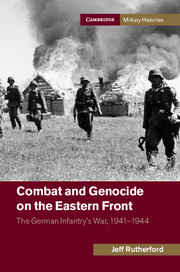Book contents
- Frontmatter
- Table of contents
- List of illustrations
- List of figures
- List of maps
- List of tables
- Acknowledgments
- Introduction
- 1 The Wehrmacht and German society
- 2 Preparations for war
- 3 “Attack with a ruthless offensive spirit and … a firestorm of destruction”
- 4 “Will the continuation of this attackbe worth it?”
- 5 “It is only a question of where, not if, civilians will starve”
- 6 The failure of Operation Barbarossa
- 7 The Soviet winter offensive, 1942
- 8 “The population … shouted out to the interpreter that one would rather be shot instead of being left to starve”
- 9 “From one mess to another”
- 10 “We need to fight to the end, so oder so”
- 11 A more rational occupation?
- 12 “As miserable representatives of themiserable twentieth century, we burnedall of the villages”
- Conclusion
- Bibliography
- Index
- References
10 - “We need to fight to the end, so oder so”
Combat and the reconstruction of Army Group North
Published online by Cambridge University Press: 05 July 2014
- Frontmatter
- Table of contents
- List of illustrations
- List of figures
- List of maps
- List of tables
- Acknowledgments
- Introduction
- 1 The Wehrmacht and German society
- 2 Preparations for war
- 3 “Attack with a ruthless offensive spirit and … a firestorm of destruction”
- 4 “Will the continuation of this attackbe worth it?”
- 5 “It is only a question of where, not if, civilians will starve”
- 6 The failure of Operation Barbarossa
- 7 The Soviet winter offensive, 1942
- 8 “The population … shouted out to the interpreter that one would rather be shot instead of being left to starve”
- 9 “From one mess to another”
- 10 “We need to fight to the end, so oder so”
- 11 A more rational occupation?
- 12 “As miserable representatives of themiserable twentieth century, we burnedall of the villages”
- Conclusion
- Bibliography
- Index
- References
Summary
Nineteen forty-three has been variously described as both the “forgotten year” and the “culmination year” of the Second World War. While the latter description certainly applies to the dramatic and decisive events that took place on the southern and center sections of the Eastern Front, the former could be aptly applied to Army Group North and its area of operations. Even more so than in the preceding year, the significance of the northwestern Russian theater paled in comparison to that of the remainder of the east. In the far south, Soviet forces smashed the German Sixth Army at Stalingrad and threatened to destroy all of Army Group South, the most powerful German field formation. While the Wehrmacht temporarily regained the initiative with Manstein’s counterattack and seizure of Kharkov in March 1943, the situation in southern Russia remained exceptionally threatening to German forces. Soviet forces also launched a large-scale attack on the Rzhev salient in the center of the front that, while ultimately ending in failure for the Red Army, nonetheless increased the pressure on the Wehrmacht in late 1942 and early 1943.
The 1943 German summer offensive was designed to eliminate the bulge centered on Kursk created by the Rzhev and Kharkov fighting. Powerful Wehrmacht formations from Army Groups Center and South launched Operation Zitadelle on 5 July. Culminating in an unprecedented clash of armor, Red Army defenses blunted the German advance, allowing the Soviets to open up their first successful summer offensive, one that ended with Red Army troops reoccupying most Soviet territory.
- Type
- Chapter
- Information
- Combat and Genocide on the Eastern FrontThe German Infantry's War, 1941–1944, pp. 305 - 329Publisher: Cambridge University PressPrint publication year: 2014



